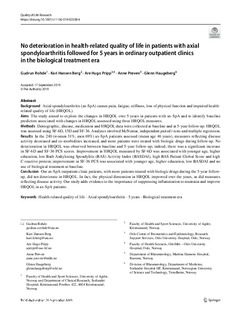| dc.description.abstract | Background
Axial spondyloarthritis (ax-SpA) causes pain, fatigue, stiffness, loss of physical function and impaired health-related quality of life (HRQOL).
Aims
The study aimed to explore the changes in HRQOL over 5 years in patients with ax-SpA and to identify baseline predictors associated with changes in HRQOL assessed using three HRQOL measures.
Methods
Demographic, disease, medication and HRQOL data were collected at baseline and at 5-year follow-up. HRQOL was assessed using SF-6D, 15D and SF-36. Analyses involved McNemar, independent paired t tests and multiple regression.
Results
In the 240 (women 31%, men 69%) ax-SpA patients assessed (mean age 46 years), measures reflecting disease activity decreased and co-morbidities increased, and more patients were treated with biologic drugs during follow-up. No deterioration in HRQOL was observed between baseline and 5-year follow-up; indeed, there was a significant increase in SF-6D and SF-36 PCS scores. Improvement in HRQOL measured by SF-6D was associated with younger age, higher education, low Bath Ankylosing Spondylitis (BAS) Activity Index (BASDAI), high BAS Patient Global Score and high C-reactive protein; improvement in SF-36 PCS was associated with younger age, higher education, low BASDAI and no use of biological treatment at baseline.
Conclusion
Our ax-SpA outpatient clinic patients, with more patients treated with biologic drugs during the 5-year follow-up, did not deteriorate in HRQOL. In fact, the physical dimension in HRQOL improved over the years, as did measures reflecting disease activity. Our study adds evidence to the importance of suppressing inflammation to maintain and improve HRQOL in ax-SpA patients. | nb_NO |

